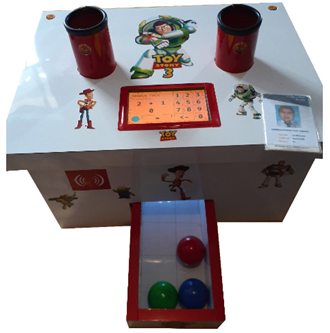Electronic toy for children with hyperactivity disorder in early education
Main Article Content
Abstract
This paper describes the development of a prototype electronic toy capable of teaching, in a participatory and entertaining way, the basic concepts of addition in Basic Mathematics. The main objective is the development of a toy that allows hyperactive children to improve their learning using a ball-based game, which also contributes to the development of their logical thinking and can quickly respond to the teacher's indications and orientations. Through an exploratory and descriptive methodology, previous research is carried out to define the most successful didactic strategies in the treatment of hyperactivity and, thus, establish the design parameters of the electronic device. The results obtained during the functional tests demonstrated that the children who participated in the project showed greater interest in solving mathematical problems and recognizing colors, with a % of success (knowledge retention) of 86%. Therefore, the interactive digital system contributes to learning development.
Article Details

This work is licensed under a Creative Commons Attribution 4.0 International License.
Authors who publish in this journal agree to the following terms: Authors retain the copyright and guarantee the journal the right to be the first publication of the work, as well as, licensed under a Creative Commons Attribution License that allows others share the work with an acknowledgment of the authorship of the work and the initial publication in this journal. Authors may separately establish additional agreements for the non-exclusive distribution of the version of the work published in the journal (for example, placing it in an institutional repository or publishing it in a book), with acknowledgment of its initial publication in this journal. Authors are allowed and encouraged to disseminate their work electronically (for example, in institutional repositories or on their own website) before and during the submission process, as it may lead to productive exchanges as well as further citation earliest and oldest of published works.
How to Cite
References
[2] Fundación CADAH, 2012. [En línea]. Available: https://www.fundacioncadah.org/web/articulo/tdah-y-trastornos-del-aprendizaje.html. [Último acceso: 2020].
[3] J. López-Ibor, M. Valdés, “Manual diagnóstico y estadístico de los trastornos mentales”, Barcelona, España: Masson, 1995.
[4] H. Ferreyra, S. Vidales y G. Peretti, “Una propuesta para el desarrollo de capacidades,” Mejora en los aprendizajes de la Lengua, Matemáticas y Ciencia, no. 2, pp. 1-15, 2014.
[5] M. E. Anaya Meneses, «Siete olmedo,» 2016. [En línea]. Available: https://www.sieteolmedo.com.mx/2013/04/07/desarrollo-motriz-en-el-nino-etapas-y-sugerencias-para-su-estimulacion/. [Último acceso: 2020].
[6] FDA. US. FOOD & DRUG ADMINISTRATION, “FAD NEWS RELEASE,” [En línea]. Available: https://www.fda.gov/news-events/press-announcements. [Último acceso: 2020]
[7] Akili Interactive, Endevor Rx, “Endevor Rx,” 2020. [En línea]. Available: https://www.endeavorrx.com/. [Último acceso: 2020].
[8] Bouncyband, “Bouncyband,” 2020. [En línea]. Available: https://bouncyband.com/products/fidget-phone.
[9] Fundación CADAH, Fundacióncadah.org, 2012. [En línea]. Available: https://www.fundacioncadah.org/web/articulo/bajo-rendimiento-escolar-y-tdah.html.
[10] R. Hernández Sampieri , C. Fernández Collado y L. Pilar Baptista, Metodología de la investigación, 6 ta edición ed., México DF: Mc Graw Hill, 2014.
[11] M. Balestrini Acuña, Cómo se elabora el proyecto de investigación, 7ma edición ed., Caracas: BL Consultores asociados servicios editoriales, 2005.
[12] J. Lozada, “Definición, Propiedad Intelectual e Industria,” CienciAmérica, vol. 3, no. 1, pp. 47-50, 2014.
[13] A. M. Bavaresco de Prieto, Proceso metodológico en la investigación, Sexta edición ed., Maracaibo: Imprenta Internacional, CA, 2013.
[14] J. M. Angulo Usategui, Robótica práctica: tecnologías y aplicaciones., Barcelona: Paraninfo, 1986.

